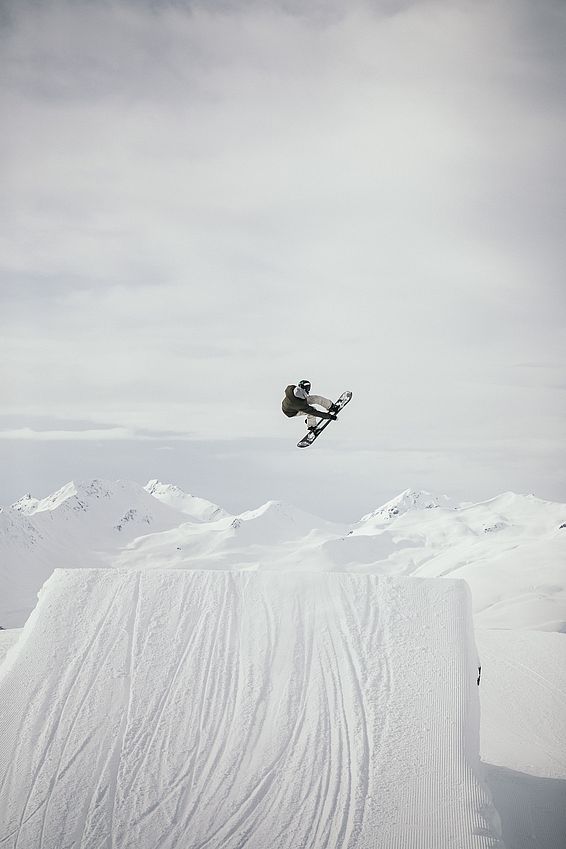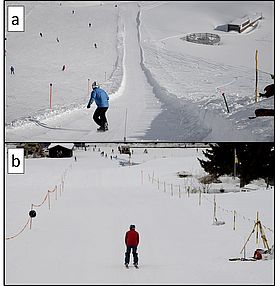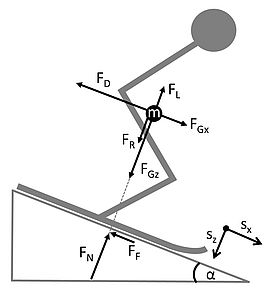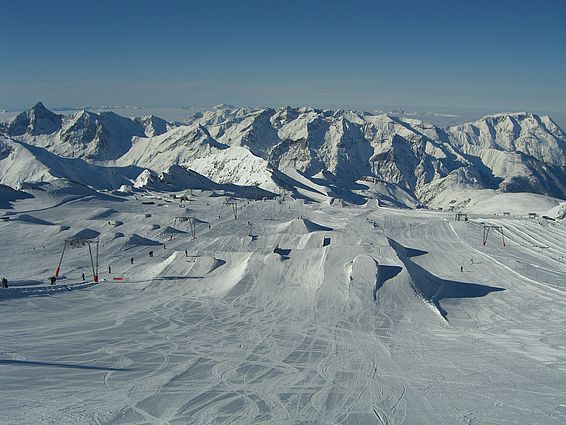In slopestyle and big air, the friction of freestyle skis and snowboards on snow significantly affects the speed of approach on big jumps. Using experimental methods, researchers at the WSL Institute for Snow and Avalanche Research SLF have developed a model that can predict this friction based on the physical parameters of the snow. This has direct implications for inrun design, meaning enhanced safety in these disciplines and a reduced risk of injury.
With its range of features such as jumps, rails and boxes, designing a slopestyle park requires a great deal of experience and know-how. The geometry of jumps (also known as 'kickers') is complex, but a well-designed jump reduces the risk of injury. A key factor here is ensuring that the steep landing zone, known as the sweet spot, is as long as possible and in line with the flight curve. This gives athletes some leeway, allowing them to make slightly longer or shorter jumps without too heavy an impact on landing. If they jump too far or not far enough, they risk serious injury. For a jump to be executed well with a landing in the sweet spot, the inrun needs to be long enough and an optimal speed attained during the jump. This speed depends on many parameters, including the coefficient of friction of the snow during the run. Other forces, such as aerodynamic and gravitational forces, also have an effect. “We know that friction is heavily dependent on snow condition, but until now there have been no good models for predicting this friction in given snow conditions. To remedy this, we carried out a number of practical experiments," says study leader Fabian Wolfsperger of the SLF's Winter Sports and Climate group. For the first time, kinematic data from athletes and comprehensive snow surface measurements have been combined to determine the coefficient of friction of freestyle skis and snowboards in a variety of snow conditions.
Test runs on two different tracks ¶
To determine the friction of freestyle skis and snowboards in different snow conditions, Wolfsperger analysed over 200 test runs on two test tracks in the Davos ski resort over the course of two winters. The test runs were performed with freestyle skis and snowboards in a range of snow conditions. On each of the 13 test days, which were characterised by different weather conditions, a snowboarder or skier descended the test track in the inrun position. The speed profiles of the runs were recorded with precise GPS measurements and then analysed. At the same time, the researchers examined the snow, its condition, grain shape and size, temperature and wetness and were able to relate this data to the speed of travel. Finally, by incorporating aerodynamic measurements of the athletes recorded in a wind tunnel, it was possible to chart the coefficient of friction between the snow and the skis/snowboard on each individual run. This enabled physical snow parameters to be linked with friction for the first time, revealing the extent to which different snow and weather conditions slow down a skier or snowboarder.
Simple, practical methods for calculating snow friction ¶
The experiments showed that the condition of the snow is the biggest factor influencing friction, and identified how much friction is generated on freestyle skis and snowboards in different snow conditions. Based on the study's findings and the data presented, it is now possible to predict what the friction will be from the prevailing physical properties of the snow. For example, wet, new fallen snow has a relatively high coefficient of friction, around three times higher than dry, frozen spring snow.
Combining kinematic data from athletes and comprehensive snow surface measurements for the first time has led to the development of a tool that will allow park designers and competition organisers to predict the friction of freestyle skis and snowboards on snow.
"Our results provide a new quantitative tool for industry professionals to predict the friction of skis and snowboards on snow under different conditions. This should improve the safety of athletes in slopestyle and big air," says Wolfsperger. As an alternative to calculating friction from physical snow parameters, which requires the use of special measuring instruments, professionals can also make a rough estimate of the snow friction on a groomed slope using a thermometer and a visual assessment of the snow. This allows them to determine the prevailing snow category, and thus the friction, provided they also take into account the weather over the past and next 24 hours.
The study also found that snow friction can change not only from day to day, but also within hours. For Olympic freestyle disciplines like slopestyle or big air, it is important to understand this variability. The new insights should help organisers to determine the timing of competitions and to decide whether, in certain conditions such as rising temperatures, it might make sense to suspend the competition until later in the day when the temperatures are cooler and the snow has cooled down again, to make things as safe and fair as possible for competitors.
Contact ¶
Publications ¶
Copyright ¶
WSL and SLF provide the artwork for imaging of press articles relating to this media release for free. Transferring and saving the images in image databases and saving of images by third parties is not allowed.




